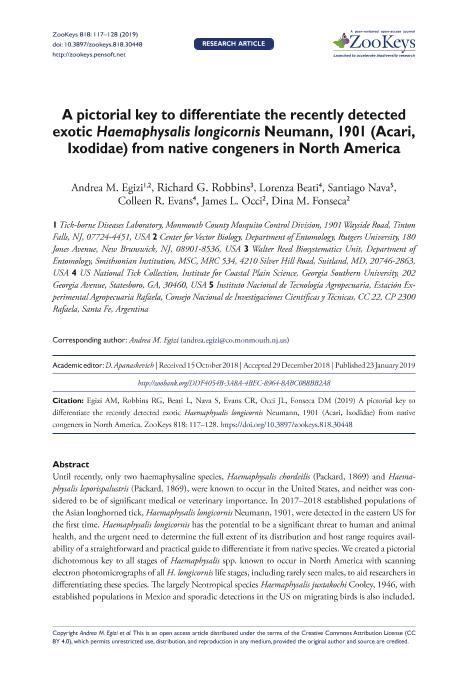Artículo
A pictorial key to differentiate the recently detected exotic Haemaphysalis longicornis Neumann, 1901 (Acari, Ixodidae) from native congeners in North America
Egizi, Andrea M.; Robbins, Richard G.; Beati, Lorenza; Nava, Santiago ; Evans, Colleen R.; Occi, James L.; Fonseca, Dina M.
; Evans, Colleen R.; Occi, James L.; Fonseca, Dina M.
 ; Evans, Colleen R.; Occi, James L.; Fonseca, Dina M.
; Evans, Colleen R.; Occi, James L.; Fonseca, Dina M.
Fecha de publicación:
01/2019
Editorial:
Pensoft Publishers
Revista:
ZooKeys
ISSN:
1313-2989
e-ISSN:
1313-2970
Idioma:
Inglés
Tipo de recurso:
Artículo publicado
Clasificación temática:
Resumen
Until recently, only two haemaphysaline species, Haemaphysalis chordeilis (Packard, 1869) and Haemaphysalisleporispalustris (Packard, 1869), were known to occur in the United States, and neither was consideredto be of significant medical or veterinary importance. In 2017?2018 established populations ofthe Asian longhorned tick, Haemaphysalis longicornis Neumann, 1901, were detected in the eastern US forthe first time. Haemaphysalis longicornis has the potential to be a significant threat to human and animalhealth, and the urgent need to determine the full extent of its distribution and host range requires availabilityof a straightforward and practical guide to differentiate it from native species. We created a pictorialdichotomous key to all stages of Haemaphysalis spp. known to occur in North America with scanningelectron photomicrographs of all H. longicornis life stages, including rarely seen males, to aid researchers indifferentiating these species. The largely Neotropical species Haemaphysalis juxtakochi Cooley, 1946, withestablished populations in Mexico and sporadic detections in the US on migrating birds is also included.
Palabras clave:
TICKS
,
TAXONOMY
,
HAEMAPHYSALIS
Archivos asociados
Licencia
Identificadores
Colecciones
Articulos(CCT - SANTA FE)
Articulos de CTRO.CIENTIFICO TECNOL.CONICET - SANTA FE
Articulos de CTRO.CIENTIFICO TECNOL.CONICET - SANTA FE
Citación
Egizi, Andrea M.; Robbins, Richard G.; Beati, Lorenza; Nava, Santiago; Evans, Colleen R.; et al.; A pictorial key to differentiate the recently detected exotic Haemaphysalis longicornis Neumann, 1901 (Acari, Ixodidae) from native congeners in North America; Pensoft Publishers; ZooKeys; 818; 1-2019; 117-128
Compartir
Altmétricas



